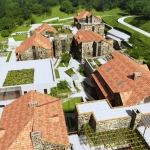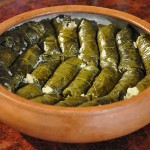The Memorial of the Battle of Musaler
The Armenians have struggled for their freedom and faith for centuries. Tragic and heroic pages in the history of Armenian people have always been closely intertwined with each other. And the same is with the events of 1915. We always remember the Armenian Genocide and the heroic battle of Musaler together.
The monument symbolizing the victory of Armenians in the battle of Musaler stands on the right side of the highway to Etchmiadzin, the religious center of all Armenians. The memorial is an imposing building in orange color with moderate and severe style. It also presents itself as the museum of the battle which is the symbol of the events that took place during the Armenian Genocide of 1915 when the Armenians had to leave their homes and lands being sentenced to deportation by the command of the Ottoman Empire.
But the habitants of village Musaler which was situated on the shores of the Mediterranean Sea in historical Armenia ignoring the commands decided to climb up to the top of the mountain Musadagh and organize self defense. And for 40 days they confronted the Turkish armed regular troops. The heard conditions could not shatter the struggling spirit of the Armenians. The habitats of Musaler remained adamant.
Here are the events for which nowadays the monument stands proudly to testify the heroic spiritual identity of the Armenians. This memorial monument is situated in village Musaler of Armavir region and is built by the heirs of those who emigrated from village Musaler of Western Armenia.
Now once a year the people of Musaler gather together near the monument which has become a unique sacred place for pilgrims and celebrate the victory of their predecessors. On the day of celebrations near the memorial you can see 40 copper pans in which people make “harisa”. Harisa is an Armenian national dish, a kind of porridge made of wheat and lamb meat which is boiled in pans all night long. People gather around the fire, camp in the surroundings of the monument and cheer up all the night. Then in the morning they distribute the porridge – “harisa” to the all assembled and continue the fete. By the way, there are only 14 families in the village that have destiny to prepare the festive “harisa” and this right is passed by succession from father to son.
Later these historical events inspired Austrian writer Franz Werfel to write the novel “Forty Days of Musa Dagh”. The novel completely exposes and describes the difficulties and sorrows that the Armenians passed through during the battle of Musaler. But it also shows our stern will and free living soul. Today the integral part of celebrations is the performances which present the parts from the novel which perfectly describes the brevity and struggling nature of all Armenians.











